ECON20039 Term 3: Research Essay on Price Elasticity and Oligopolies
VerifiedAdded on 2022/08/29
|23
|4871
|13
Essay
AI Summary
This economics assignment addresses two key concepts: price elasticity of demand and oligopoly markets. The first part defines price elasticity, its various types (perfectly elastic, perfectly inelastic, relatively elastic, relatively inelastic, and unitary elastic), and its importance for producers in setting prices. The assignment provides real-world examples of elasticity estimates for energy products (gasoline, car fuels, electricity) and soft drinks, drawing from economic journals. The second part delves into the characteristics of an oligopoly market, including few sellers, interdependence, competition, product nature, entry barriers, and advertising. The assignment then applies these characteristics to the car manufacturing industry, highlighting its oligopolistic nature due to the dominance of a few firms, high entry barriers, product differentiation, and intense competition. The solution offers a comprehensive analysis supported by relevant economic literature and real-world examples.
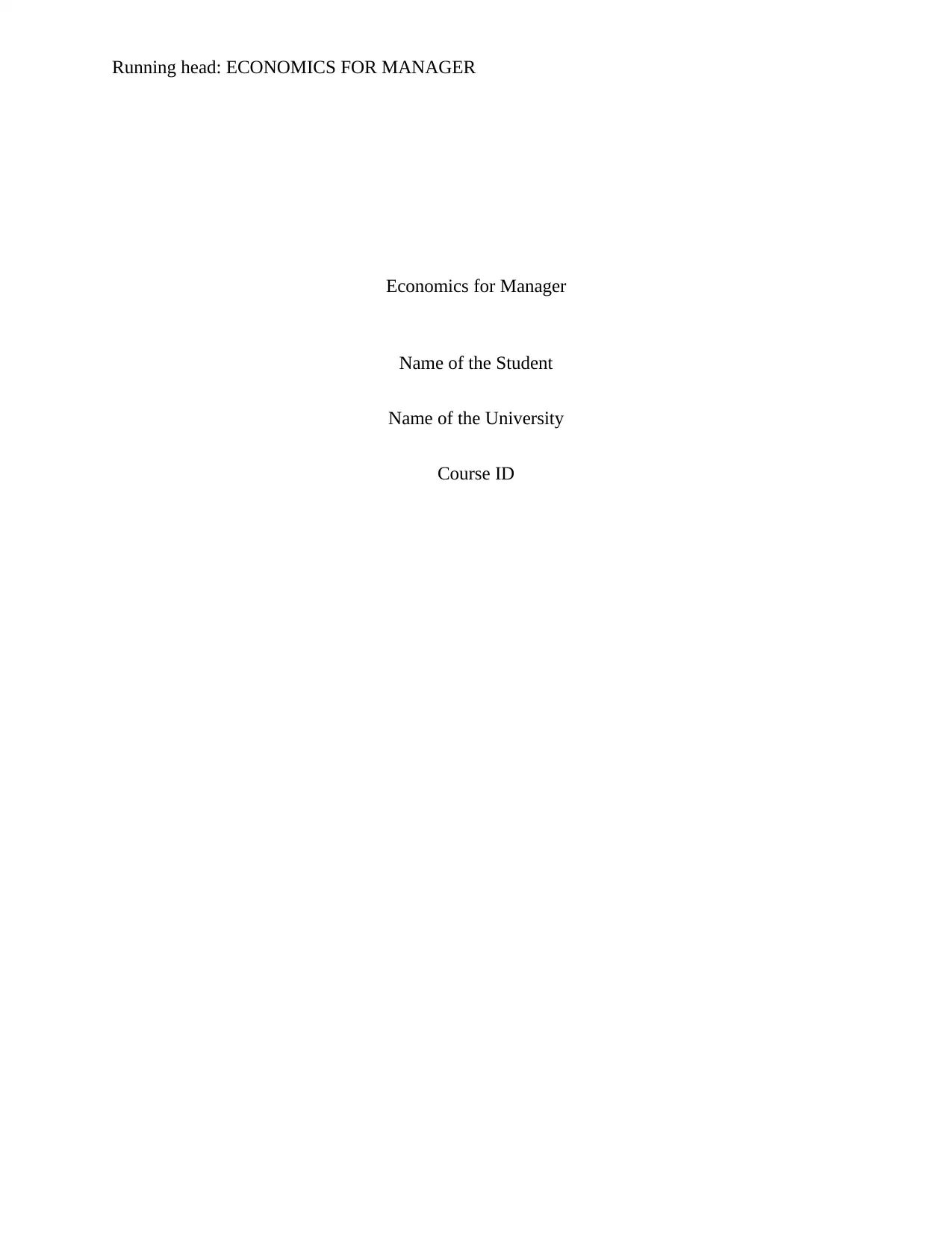
Running head: ECONOMICS FOR MANAGER
Economics for Manager
Name of the Student
Name of the University
Course ID
Economics for Manager
Name of the Student
Name of the University
Course ID
Paraphrase This Document
Need a fresh take? Get an instant paraphrase of this document with our AI Paraphraser
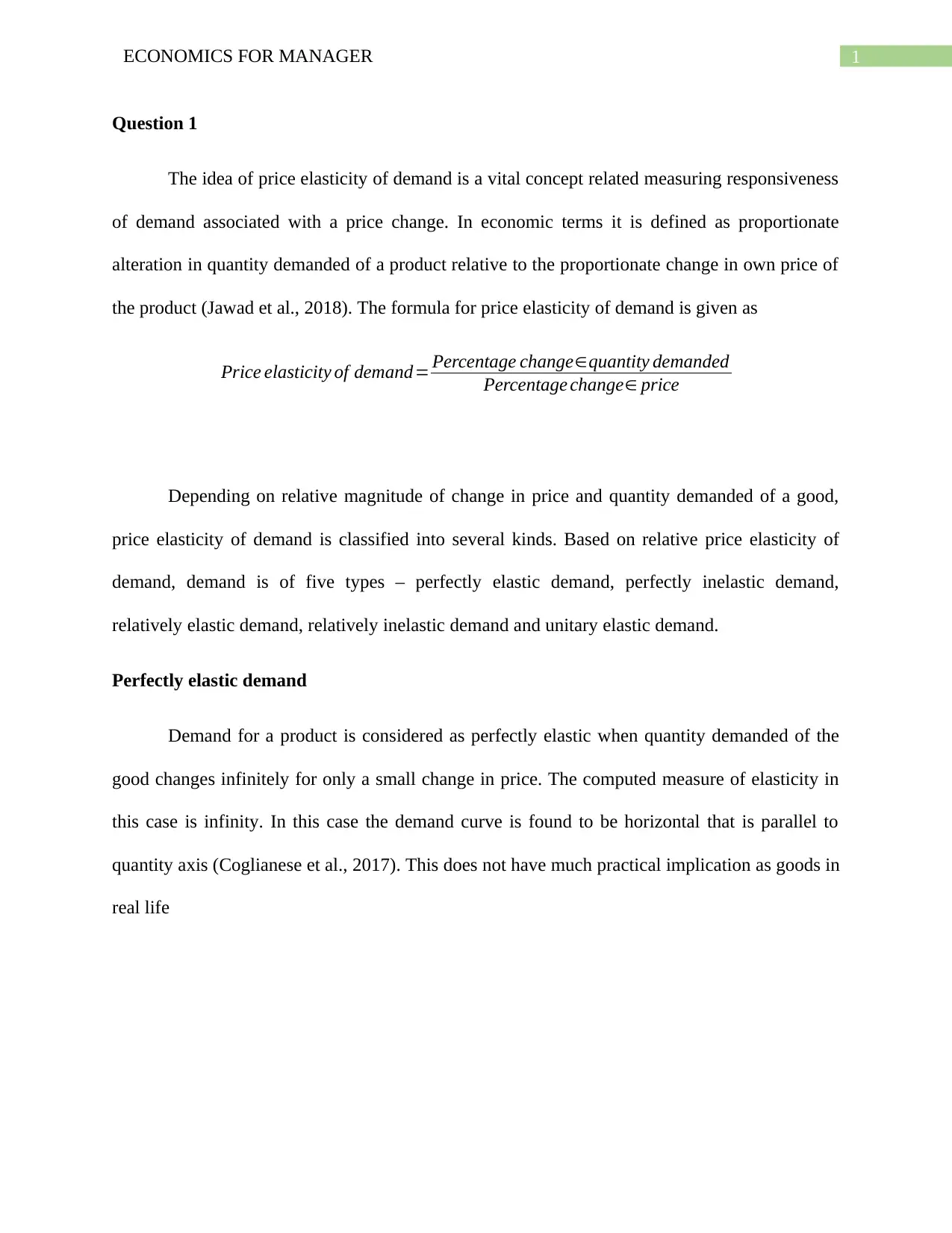
1ECONOMICS FOR MANAGER
Question 1
The idea of price elasticity of demand is a vital concept related measuring responsiveness
of demand associated with a price change. In economic terms it is defined as proportionate
alteration in quantity demanded of a product relative to the proportionate change in own price of
the product (Jawad et al., 2018). The formula for price elasticity of demand is given as
Price elasticity of demand= Percentage change∈quantity demanded
Percentage change∈ price
Depending on relative magnitude of change in price and quantity demanded of a good,
price elasticity of demand is classified into several kinds. Based on relative price elasticity of
demand, demand is of five types – perfectly elastic demand, perfectly inelastic demand,
relatively elastic demand, relatively inelastic demand and unitary elastic demand.
Perfectly elastic demand
Demand for a product is considered as perfectly elastic when quantity demanded of the
good changes infinitely for only a small change in price. The computed measure of elasticity in
this case is infinity. In this case the demand curve is found to be horizontal that is parallel to
quantity axis (Coglianese et al., 2017). This does not have much practical implication as goods in
real life
Question 1
The idea of price elasticity of demand is a vital concept related measuring responsiveness
of demand associated with a price change. In economic terms it is defined as proportionate
alteration in quantity demanded of a product relative to the proportionate change in own price of
the product (Jawad et al., 2018). The formula for price elasticity of demand is given as
Price elasticity of demand= Percentage change∈quantity demanded
Percentage change∈ price
Depending on relative magnitude of change in price and quantity demanded of a good,
price elasticity of demand is classified into several kinds. Based on relative price elasticity of
demand, demand is of five types – perfectly elastic demand, perfectly inelastic demand,
relatively elastic demand, relatively inelastic demand and unitary elastic demand.
Perfectly elastic demand
Demand for a product is considered as perfectly elastic when quantity demanded of the
good changes infinitely for only a small change in price. The computed measure of elasticity in
this case is infinity. In this case the demand curve is found to be horizontal that is parallel to
quantity axis (Coglianese et al., 2017). This does not have much practical implication as goods in
real life
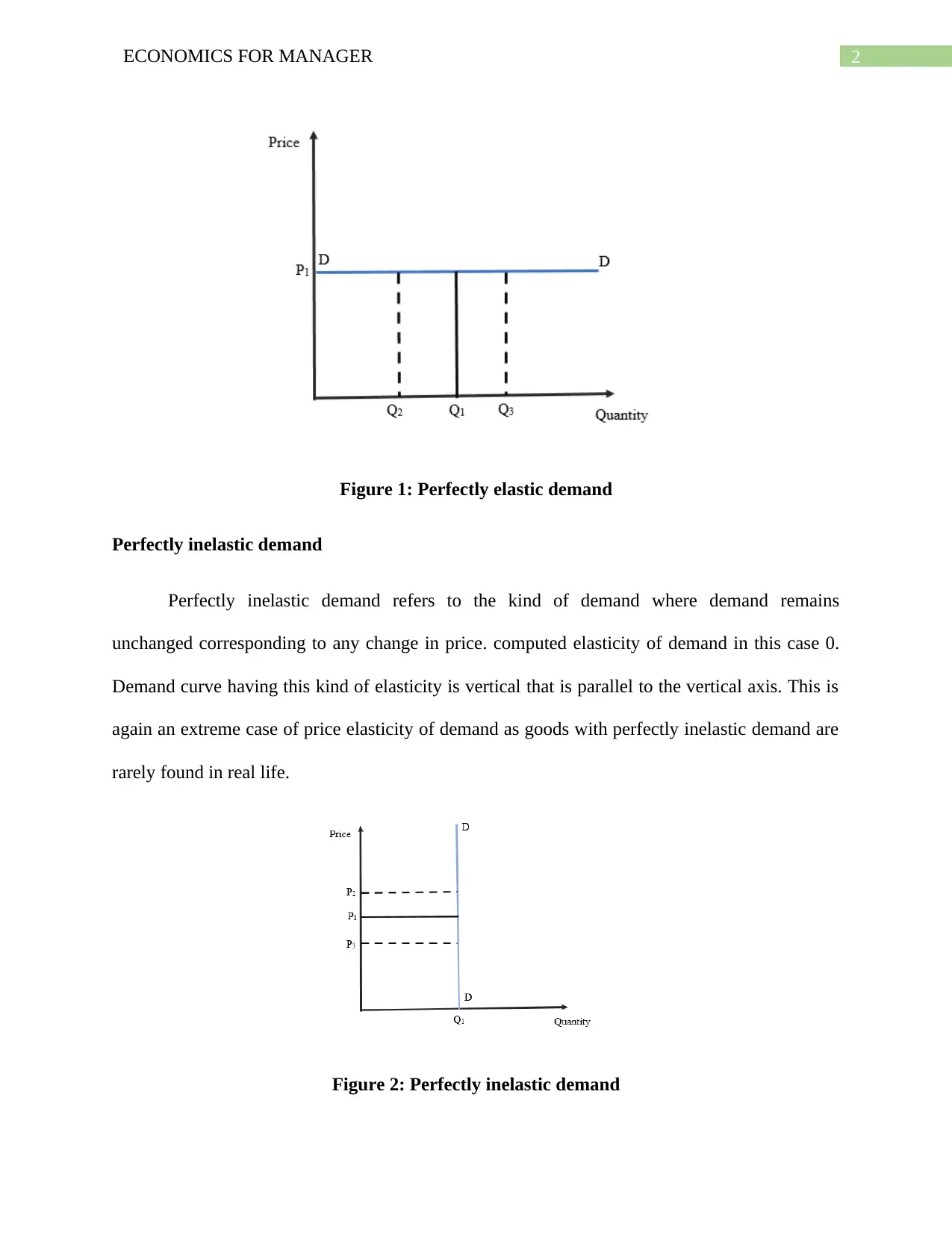
2ECONOMICS FOR MANAGER
Figure 1: Perfectly elastic demand
Perfectly inelastic demand
Perfectly inelastic demand refers to the kind of demand where demand remains
unchanged corresponding to any change in price. computed elasticity of demand in this case 0.
Demand curve having this kind of elasticity is vertical that is parallel to the vertical axis. This is
again an extreme case of price elasticity of demand as goods with perfectly inelastic demand are
rarely found in real life.
Figure 2: Perfectly inelastic demand
Figure 1: Perfectly elastic demand
Perfectly inelastic demand
Perfectly inelastic demand refers to the kind of demand where demand remains
unchanged corresponding to any change in price. computed elasticity of demand in this case 0.
Demand curve having this kind of elasticity is vertical that is parallel to the vertical axis. This is
again an extreme case of price elasticity of demand as goods with perfectly inelastic demand are
rarely found in real life.
Figure 2: Perfectly inelastic demand
⊘ This is a preview!⊘
Do you want full access?
Subscribe today to unlock all pages.

Trusted by 1+ million students worldwide

3ECONOMICS FOR MANAGER
Paraphrase This Document
Need a fresh take? Get an instant paraphrase of this document with our AI Paraphraser
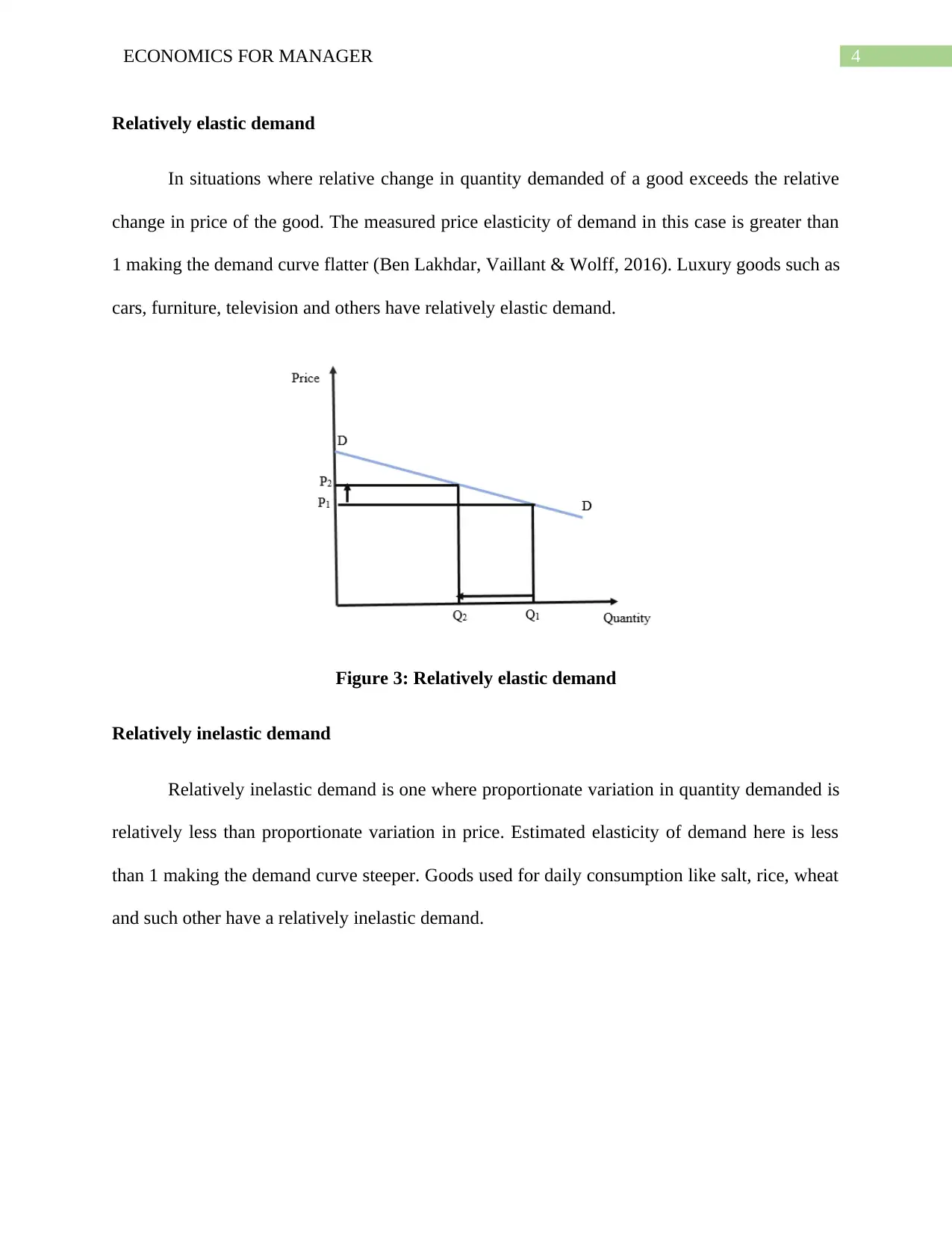
4ECONOMICS FOR MANAGER
Relatively elastic demand
In situations where relative change in quantity demanded of a good exceeds the relative
change in price of the good. The measured price elasticity of demand in this case is greater than
1 making the demand curve flatter (Ben Lakhdar, Vaillant & Wolff, 2016). Luxury goods such as
cars, furniture, television and others have relatively elastic demand.
Figure 3: Relatively elastic demand
Relatively inelastic demand
Relatively inelastic demand is one where proportionate variation in quantity demanded is
relatively less than proportionate variation in price. Estimated elasticity of demand here is less
than 1 making the demand curve steeper. Goods used for daily consumption like salt, rice, wheat
and such other have a relatively inelastic demand.
Relatively elastic demand
In situations where relative change in quantity demanded of a good exceeds the relative
change in price of the good. The measured price elasticity of demand in this case is greater than
1 making the demand curve flatter (Ben Lakhdar, Vaillant & Wolff, 2016). Luxury goods such as
cars, furniture, television and others have relatively elastic demand.
Figure 3: Relatively elastic demand
Relatively inelastic demand
Relatively inelastic demand is one where proportionate variation in quantity demanded is
relatively less than proportionate variation in price. Estimated elasticity of demand here is less
than 1 making the demand curve steeper. Goods used for daily consumption like salt, rice, wheat
and such other have a relatively inelastic demand.
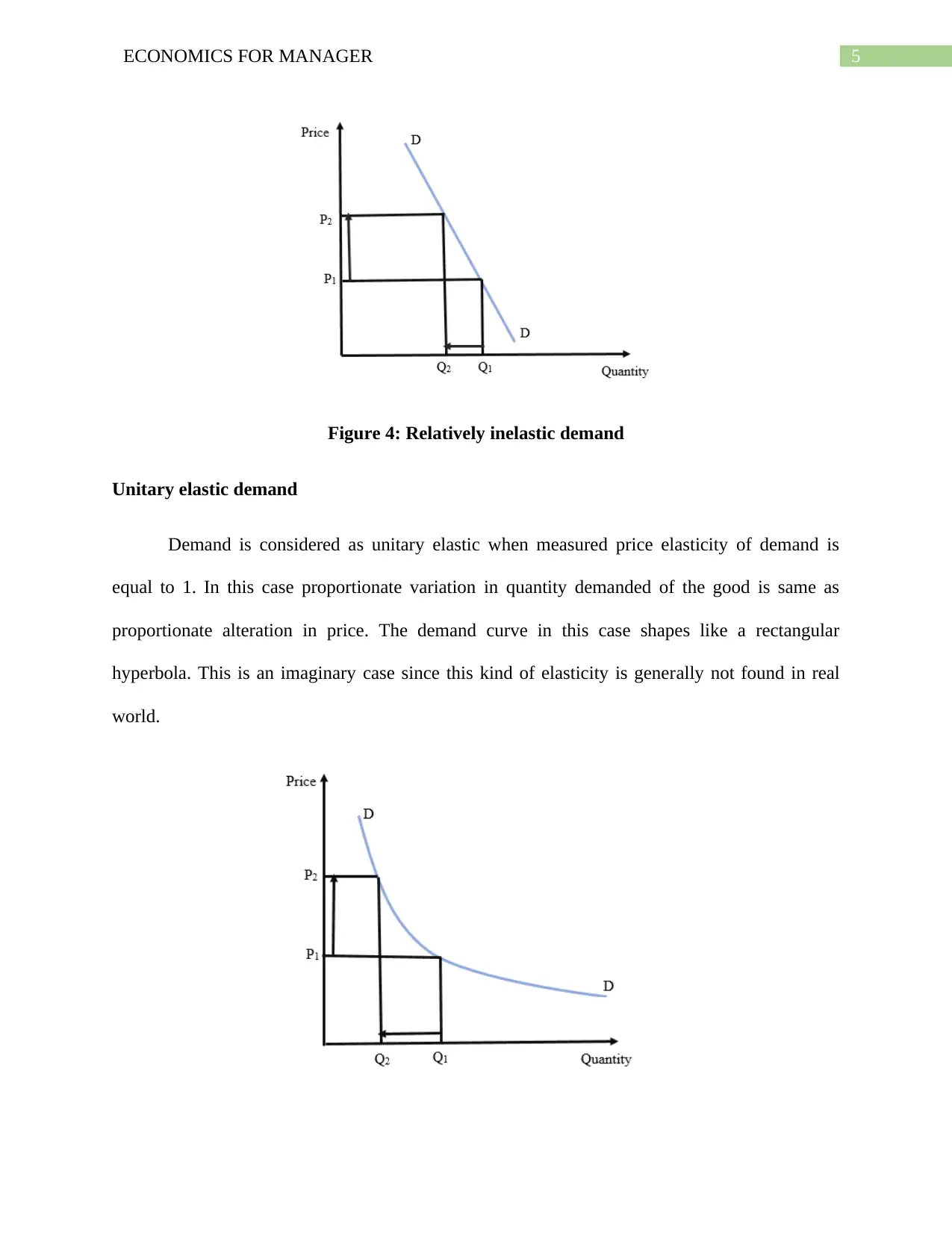
5ECONOMICS FOR MANAGER
Figure 4: Relatively inelastic demand
Unitary elastic demand
Demand is considered as unitary elastic when measured price elasticity of demand is
equal to 1. In this case proportionate variation in quantity demanded of the good is same as
proportionate alteration in price. The demand curve in this case shapes like a rectangular
hyperbola. This is an imaginary case since this kind of elasticity is generally not found in real
world.
Figure 4: Relatively inelastic demand
Unitary elastic demand
Demand is considered as unitary elastic when measured price elasticity of demand is
equal to 1. In this case proportionate variation in quantity demanded of the good is same as
proportionate alteration in price. The demand curve in this case shapes like a rectangular
hyperbola. This is an imaginary case since this kind of elasticity is generally not found in real
world.
⊘ This is a preview!⊘
Do you want full access?
Subscribe today to unlock all pages.

Trusted by 1+ million students worldwide
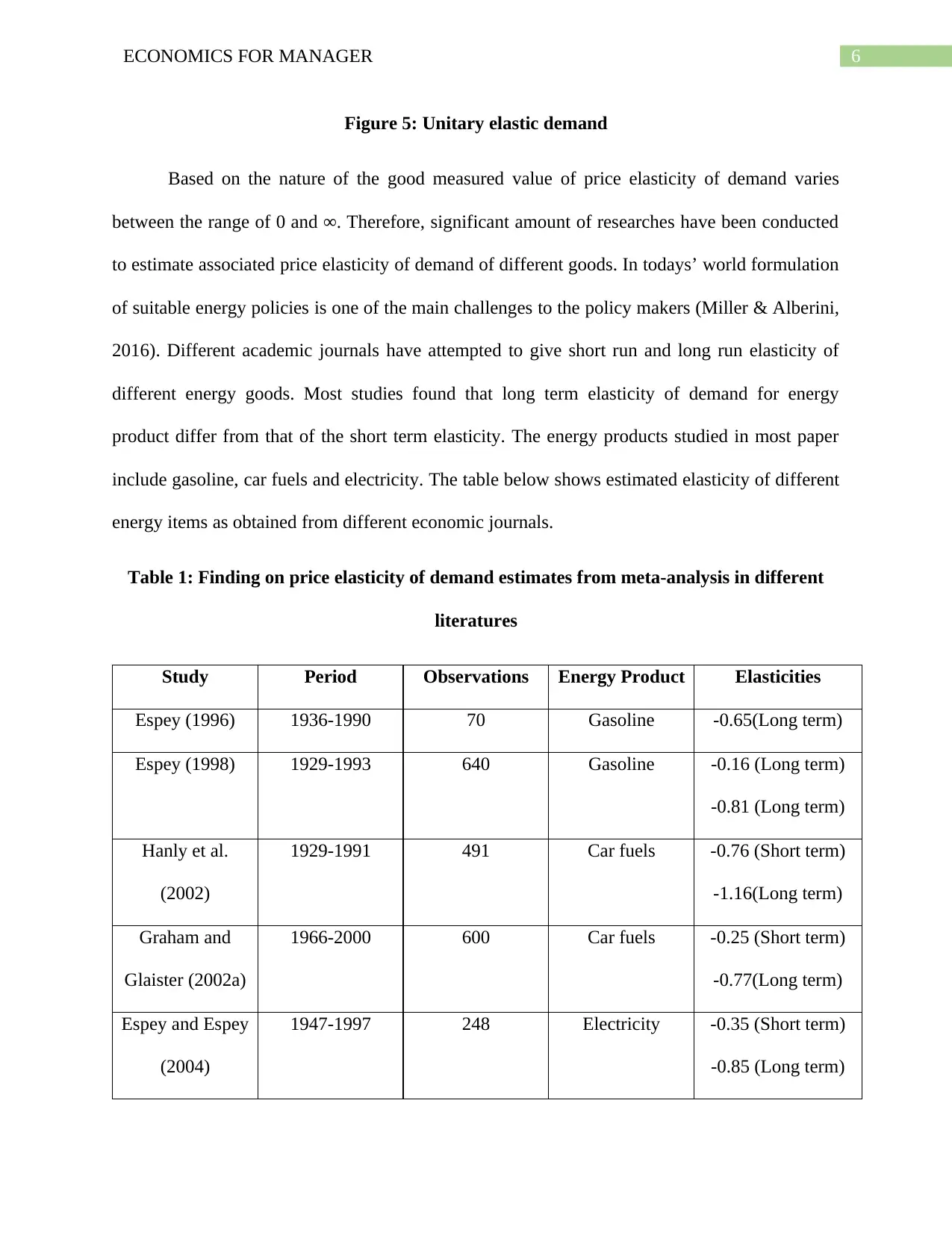
6ECONOMICS FOR MANAGER
Figure 5: Unitary elastic demand
Based on the nature of the good measured value of price elasticity of demand varies
between the range of 0 and ∞. Therefore, significant amount of researches have been conducted
to estimate associated price elasticity of demand of different goods. In todays’ world formulation
of suitable energy policies is one of the main challenges to the policy makers (Miller & Alberini,
2016). Different academic journals have attempted to give short run and long run elasticity of
different energy goods. Most studies found that long term elasticity of demand for energy
product differ from that of the short term elasticity. The energy products studied in most paper
include gasoline, car fuels and electricity. The table below shows estimated elasticity of different
energy items as obtained from different economic journals.
Table 1: Finding on price elasticity of demand estimates from meta-analysis in different
literatures
Study Period Observations Energy Product Elasticities
Espey (1996) 1936-1990 70 Gasoline -0.65(Long term)
Espey (1998) 1929-1993 640 Gasoline -0.16 (Long term)
-0.81 (Long term)
Hanly et al.
(2002)
1929-1991 491 Car fuels -0.76 (Short term)
-1.16(Long term)
Graham and
Glaister (2002a)
1966-2000 600 Car fuels -0.25 (Short term)
-0.77(Long term)
Espey and Espey
(2004)
1947-1997 248 Electricity -0.35 (Short term)
-0.85 (Long term)
Figure 5: Unitary elastic demand
Based on the nature of the good measured value of price elasticity of demand varies
between the range of 0 and ∞. Therefore, significant amount of researches have been conducted
to estimate associated price elasticity of demand of different goods. In todays’ world formulation
of suitable energy policies is one of the main challenges to the policy makers (Miller & Alberini,
2016). Different academic journals have attempted to give short run and long run elasticity of
different energy goods. Most studies found that long term elasticity of demand for energy
product differ from that of the short term elasticity. The energy products studied in most paper
include gasoline, car fuels and electricity. The table below shows estimated elasticity of different
energy items as obtained from different economic journals.
Table 1: Finding on price elasticity of demand estimates from meta-analysis in different
literatures
Study Period Observations Energy Product Elasticities
Espey (1996) 1936-1990 70 Gasoline -0.65(Long term)
Espey (1998) 1929-1993 640 Gasoline -0.16 (Long term)
-0.81 (Long term)
Hanly et al.
(2002)
1929-1991 491 Car fuels -0.76 (Short term)
-1.16(Long term)
Graham and
Glaister (2002a)
1966-2000 600 Car fuels -0.25 (Short term)
-0.77(Long term)
Espey and Espey
(2004)
1947-1997 248 Electricity -0.35 (Short term)
-0.85 (Long term)
Paraphrase This Document
Need a fresh take? Get an instant paraphrase of this document with our AI Paraphraser
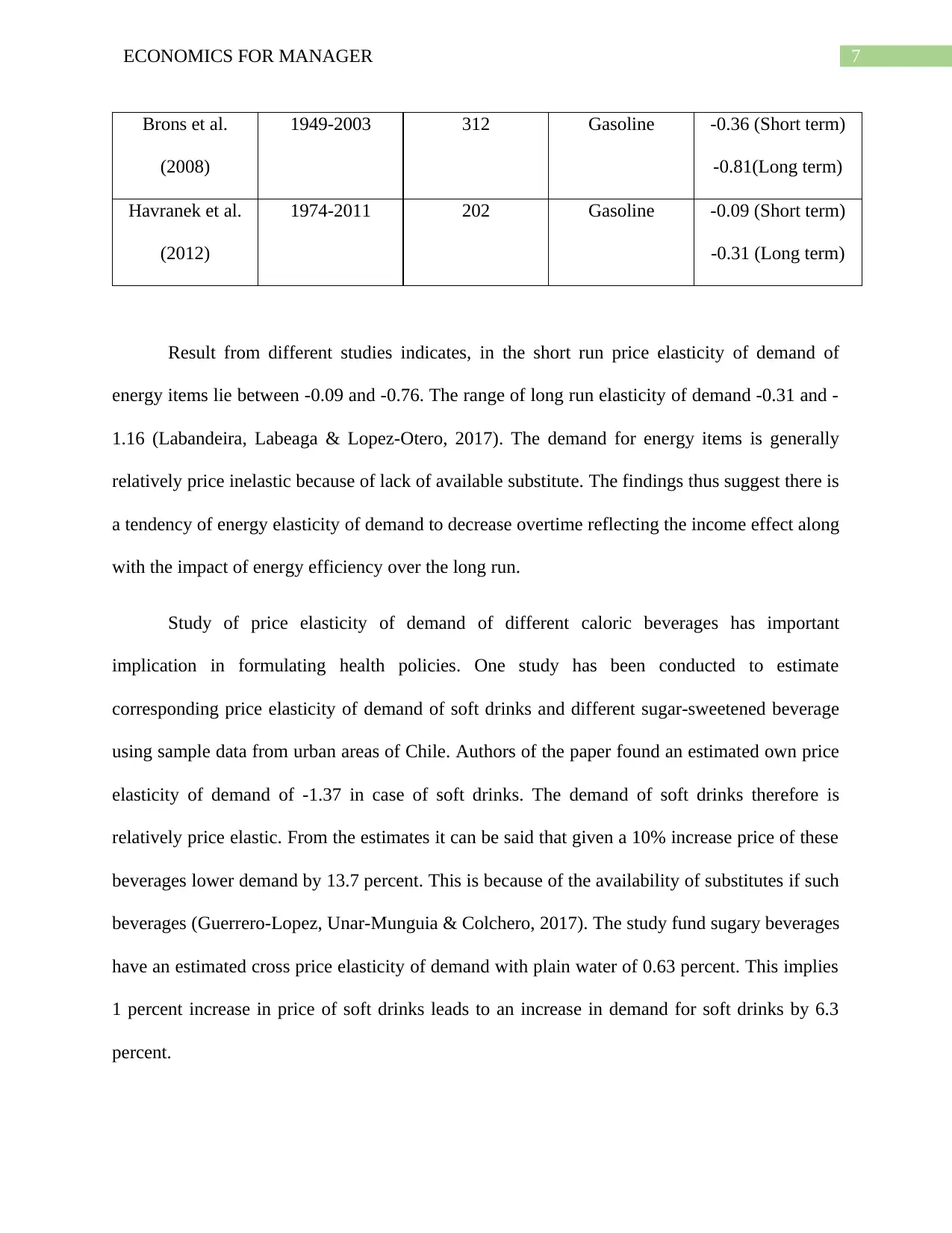
7ECONOMICS FOR MANAGER
Brons et al.
(2008)
1949-2003 312 Gasoline -0.36 (Short term)
-0.81(Long term)
Havranek et al.
(2012)
1974-2011 202 Gasoline -0.09 (Short term)
-0.31 (Long term)
Result from different studies indicates, in the short run price elasticity of demand of
energy items lie between -0.09 and -0.76. The range of long run elasticity of demand -0.31 and -
1.16 (Labandeira, Labeaga & Lopez-Otero, 2017). The demand for energy items is generally
relatively price inelastic because of lack of available substitute. The findings thus suggest there is
a tendency of energy elasticity of demand to decrease overtime reflecting the income effect along
with the impact of energy efficiency over the long run.
Study of price elasticity of demand of different caloric beverages has important
implication in formulating health policies. One study has been conducted to estimate
corresponding price elasticity of demand of soft drinks and different sugar-sweetened beverage
using sample data from urban areas of Chile. Authors of the paper found an estimated own price
elasticity of demand of -1.37 in case of soft drinks. The demand of soft drinks therefore is
relatively price elastic. From the estimates it can be said that given a 10% increase price of these
beverages lower demand by 13.7 percent. This is because of the availability of substitutes if such
beverages (Guerrero-Lopez, Unar-Munguia & Colchero, 2017). The study fund sugary beverages
have an estimated cross price elasticity of demand with plain water of 0.63 percent. This implies
1 percent increase in price of soft drinks leads to an increase in demand for soft drinks by 6.3
percent.
Brons et al.
(2008)
1949-2003 312 Gasoline -0.36 (Short term)
-0.81(Long term)
Havranek et al.
(2012)
1974-2011 202 Gasoline -0.09 (Short term)
-0.31 (Long term)
Result from different studies indicates, in the short run price elasticity of demand of
energy items lie between -0.09 and -0.76. The range of long run elasticity of demand -0.31 and -
1.16 (Labandeira, Labeaga & Lopez-Otero, 2017). The demand for energy items is generally
relatively price inelastic because of lack of available substitute. The findings thus suggest there is
a tendency of energy elasticity of demand to decrease overtime reflecting the income effect along
with the impact of energy efficiency over the long run.
Study of price elasticity of demand of different caloric beverages has important
implication in formulating health policies. One study has been conducted to estimate
corresponding price elasticity of demand of soft drinks and different sugar-sweetened beverage
using sample data from urban areas of Chile. Authors of the paper found an estimated own price
elasticity of demand of -1.37 in case of soft drinks. The demand of soft drinks therefore is
relatively price elastic. From the estimates it can be said that given a 10% increase price of these
beverages lower demand by 13.7 percent. This is because of the availability of substitutes if such
beverages (Guerrero-Lopez, Unar-Munguia & Colchero, 2017). The study fund sugary beverages
have an estimated cross price elasticity of demand with plain water of 0.63 percent. This implies
1 percent increase in price of soft drinks leads to an increase in demand for soft drinks by 6.3
percent.
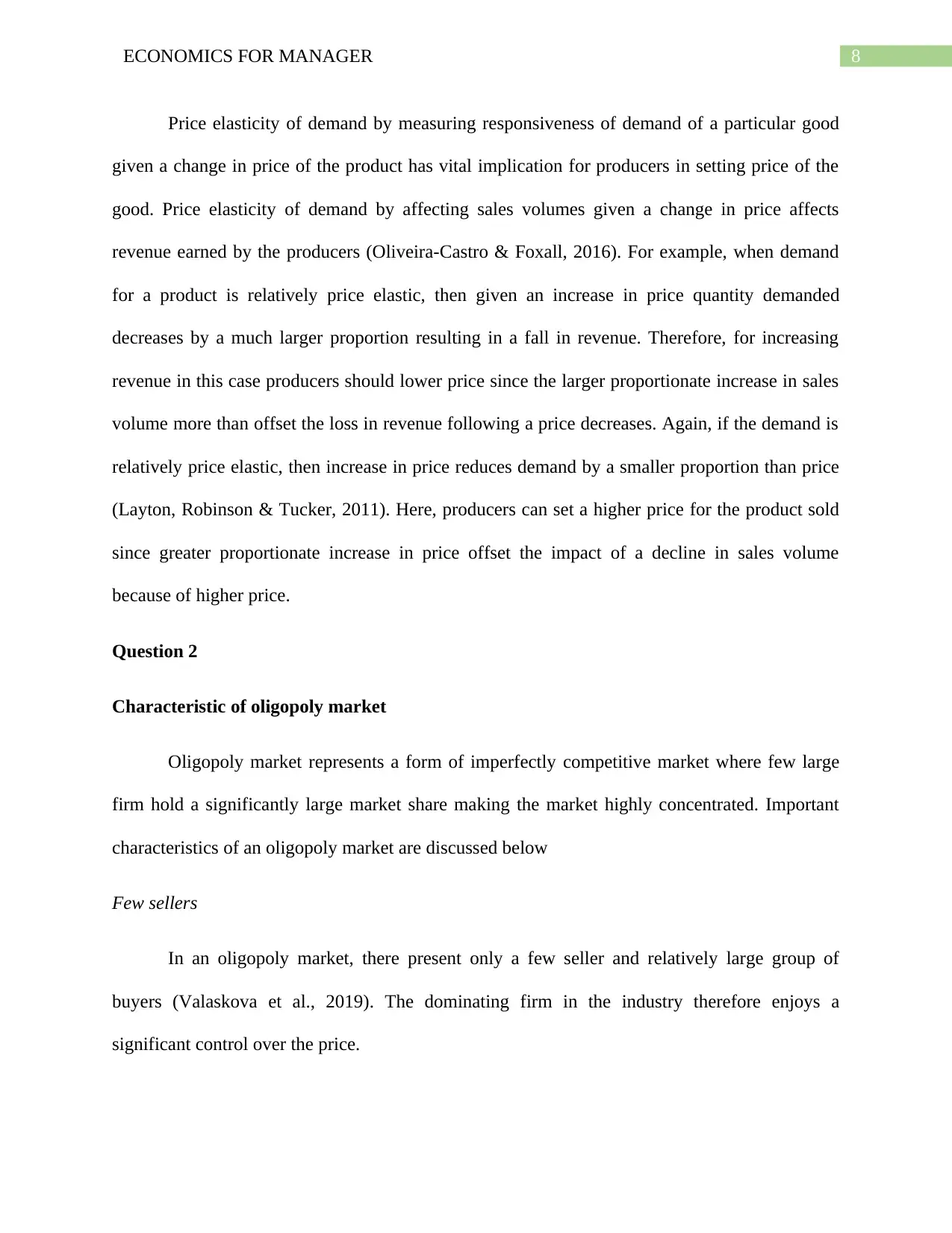
8ECONOMICS FOR MANAGER
Price elasticity of demand by measuring responsiveness of demand of a particular good
given a change in price of the product has vital implication for producers in setting price of the
good. Price elasticity of demand by affecting sales volumes given a change in price affects
revenue earned by the producers (Oliveira-Castro & Foxall, 2016). For example, when demand
for a product is relatively price elastic, then given an increase in price quantity demanded
decreases by a much larger proportion resulting in a fall in revenue. Therefore, for increasing
revenue in this case producers should lower price since the larger proportionate increase in sales
volume more than offset the loss in revenue following a price decreases. Again, if the demand is
relatively price elastic, then increase in price reduces demand by a smaller proportion than price
(Layton, Robinson & Tucker, 2011). Here, producers can set a higher price for the product sold
since greater proportionate increase in price offset the impact of a decline in sales volume
because of higher price.
Question 2
Characteristic of oligopoly market
Oligopoly market represents a form of imperfectly competitive market where few large
firm hold a significantly large market share making the market highly concentrated. Important
characteristics of an oligopoly market are discussed below
Few sellers
In an oligopoly market, there present only a few seller and relatively large group of
buyers (Valaskova et al., 2019). The dominating firm in the industry therefore enjoys a
significant control over the price.
Price elasticity of demand by measuring responsiveness of demand of a particular good
given a change in price of the product has vital implication for producers in setting price of the
good. Price elasticity of demand by affecting sales volumes given a change in price affects
revenue earned by the producers (Oliveira-Castro & Foxall, 2016). For example, when demand
for a product is relatively price elastic, then given an increase in price quantity demanded
decreases by a much larger proportion resulting in a fall in revenue. Therefore, for increasing
revenue in this case producers should lower price since the larger proportionate increase in sales
volume more than offset the loss in revenue following a price decreases. Again, if the demand is
relatively price elastic, then increase in price reduces demand by a smaller proportion than price
(Layton, Robinson & Tucker, 2011). Here, producers can set a higher price for the product sold
since greater proportionate increase in price offset the impact of a decline in sales volume
because of higher price.
Question 2
Characteristic of oligopoly market
Oligopoly market represents a form of imperfectly competitive market where few large
firm hold a significantly large market share making the market highly concentrated. Important
characteristics of an oligopoly market are discussed below
Few sellers
In an oligopoly market, there present only a few seller and relatively large group of
buyers (Valaskova et al., 2019). The dominating firm in the industry therefore enjoys a
significant control over the price.
⊘ This is a preview!⊘
Do you want full access?
Subscribe today to unlock all pages.

Trusted by 1+ million students worldwide
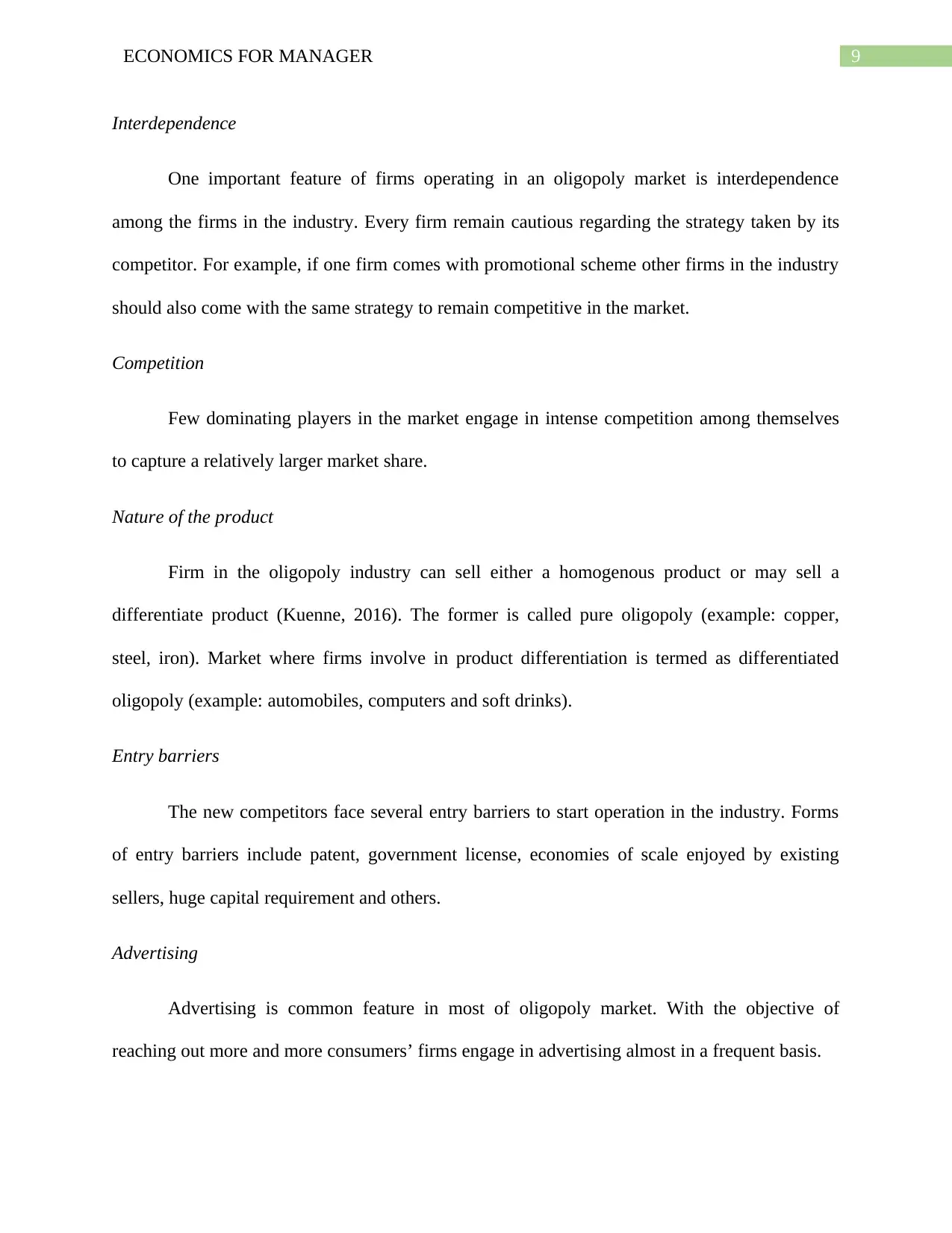
9ECONOMICS FOR MANAGER
Interdependence
One important feature of firms operating in an oligopoly market is interdependence
among the firms in the industry. Every firm remain cautious regarding the strategy taken by its
competitor. For example, if one firm comes with promotional scheme other firms in the industry
should also come with the same strategy to remain competitive in the market.
Competition
Few dominating players in the market engage in intense competition among themselves
to capture a relatively larger market share.
Nature of the product
Firm in the oligopoly industry can sell either a homogenous product or may sell a
differentiate product (Kuenne, 2016). The former is called pure oligopoly (example: copper,
steel, iron). Market where firms involve in product differentiation is termed as differentiated
oligopoly (example: automobiles, computers and soft drinks).
Entry barriers
The new competitors face several entry barriers to start operation in the industry. Forms
of entry barriers include patent, government license, economies of scale enjoyed by existing
sellers, huge capital requirement and others.
Advertising
Advertising is common feature in most of oligopoly market. With the objective of
reaching out more and more consumers’ firms engage in advertising almost in a frequent basis.
Interdependence
One important feature of firms operating in an oligopoly market is interdependence
among the firms in the industry. Every firm remain cautious regarding the strategy taken by its
competitor. For example, if one firm comes with promotional scheme other firms in the industry
should also come with the same strategy to remain competitive in the market.
Competition
Few dominating players in the market engage in intense competition among themselves
to capture a relatively larger market share.
Nature of the product
Firm in the oligopoly industry can sell either a homogenous product or may sell a
differentiate product (Kuenne, 2016). The former is called pure oligopoly (example: copper,
steel, iron). Market where firms involve in product differentiation is termed as differentiated
oligopoly (example: automobiles, computers and soft drinks).
Entry barriers
The new competitors face several entry barriers to start operation in the industry. Forms
of entry barriers include patent, government license, economies of scale enjoyed by existing
sellers, huge capital requirement and others.
Advertising
Advertising is common feature in most of oligopoly market. With the objective of
reaching out more and more consumers’ firms engage in advertising almost in a frequent basis.
Paraphrase This Document
Need a fresh take? Get an instant paraphrase of this document with our AI Paraphraser
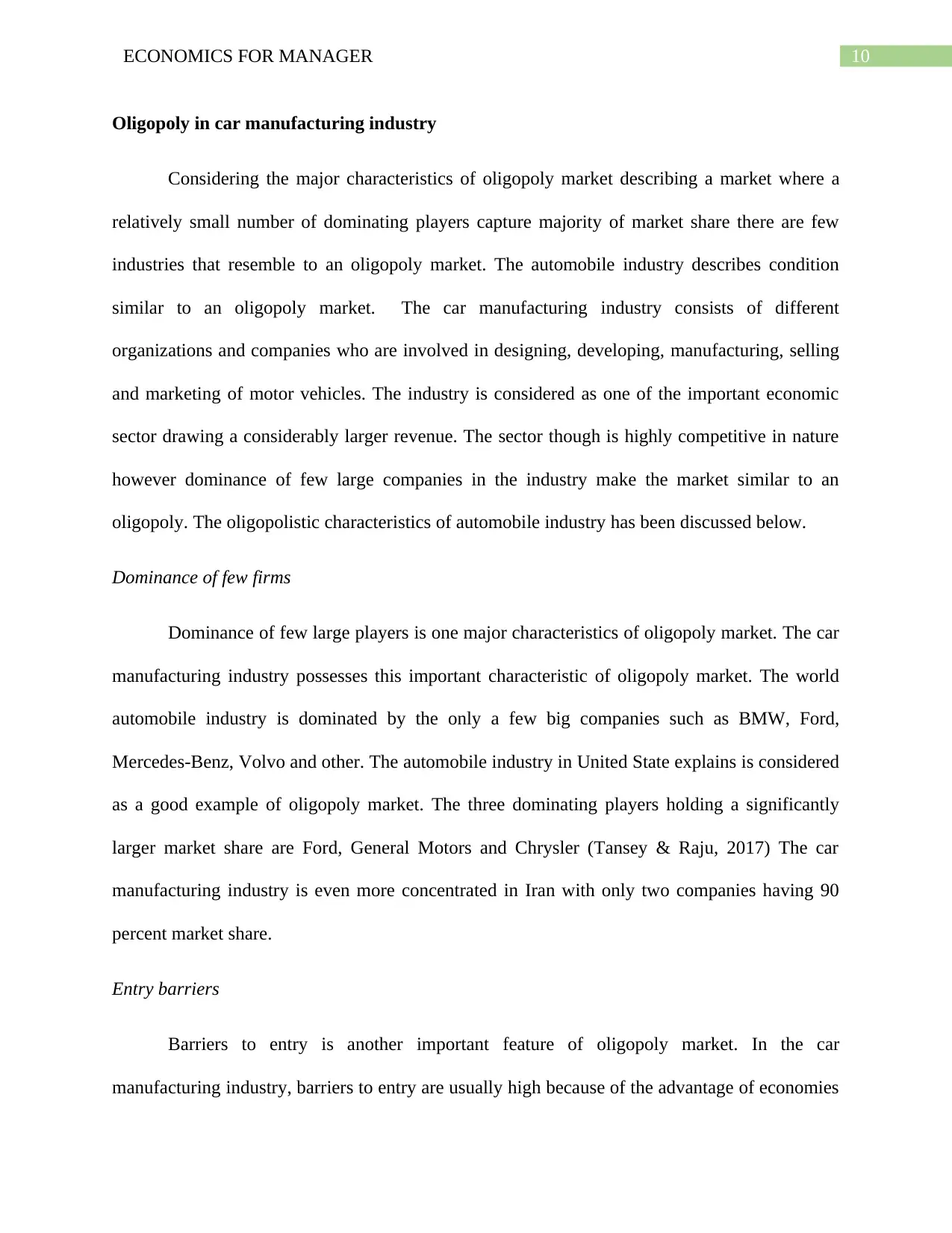
10ECONOMICS FOR MANAGER
Oligopoly in car manufacturing industry
Considering the major characteristics of oligopoly market describing a market where a
relatively small number of dominating players capture majority of market share there are few
industries that resemble to an oligopoly market. The automobile industry describes condition
similar to an oligopoly market. The car manufacturing industry consists of different
organizations and companies who are involved in designing, developing, manufacturing, selling
and marketing of motor vehicles. The industry is considered as one of the important economic
sector drawing a considerably larger revenue. The sector though is highly competitive in nature
however dominance of few large companies in the industry make the market similar to an
oligopoly. The oligopolistic characteristics of automobile industry has been discussed below.
Dominance of few firms
Dominance of few large players is one major characteristics of oligopoly market. The car
manufacturing industry possesses this important characteristic of oligopoly market. The world
automobile industry is dominated by the only a few big companies such as BMW, Ford,
Mercedes-Benz, Volvo and other. The automobile industry in United State explains is considered
as a good example of oligopoly market. The three dominating players holding a significantly
larger market share are Ford, General Motors and Chrysler (Tansey & Raju, 2017) The car
manufacturing industry is even more concentrated in Iran with only two companies having 90
percent market share.
Entry barriers
Barriers to entry is another important feature of oligopoly market. In the car
manufacturing industry, barriers to entry are usually high because of the advantage of economies
Oligopoly in car manufacturing industry
Considering the major characteristics of oligopoly market describing a market where a
relatively small number of dominating players capture majority of market share there are few
industries that resemble to an oligopoly market. The automobile industry describes condition
similar to an oligopoly market. The car manufacturing industry consists of different
organizations and companies who are involved in designing, developing, manufacturing, selling
and marketing of motor vehicles. The industry is considered as one of the important economic
sector drawing a considerably larger revenue. The sector though is highly competitive in nature
however dominance of few large companies in the industry make the market similar to an
oligopoly. The oligopolistic characteristics of automobile industry has been discussed below.
Dominance of few firms
Dominance of few large players is one major characteristics of oligopoly market. The car
manufacturing industry possesses this important characteristic of oligopoly market. The world
automobile industry is dominated by the only a few big companies such as BMW, Ford,
Mercedes-Benz, Volvo and other. The automobile industry in United State explains is considered
as a good example of oligopoly market. The three dominating players holding a significantly
larger market share are Ford, General Motors and Chrysler (Tansey & Raju, 2017) The car
manufacturing industry is even more concentrated in Iran with only two companies having 90
percent market share.
Entry barriers
Barriers to entry is another important feature of oligopoly market. In the car
manufacturing industry, barriers to entry are usually high because of the advantage of economies
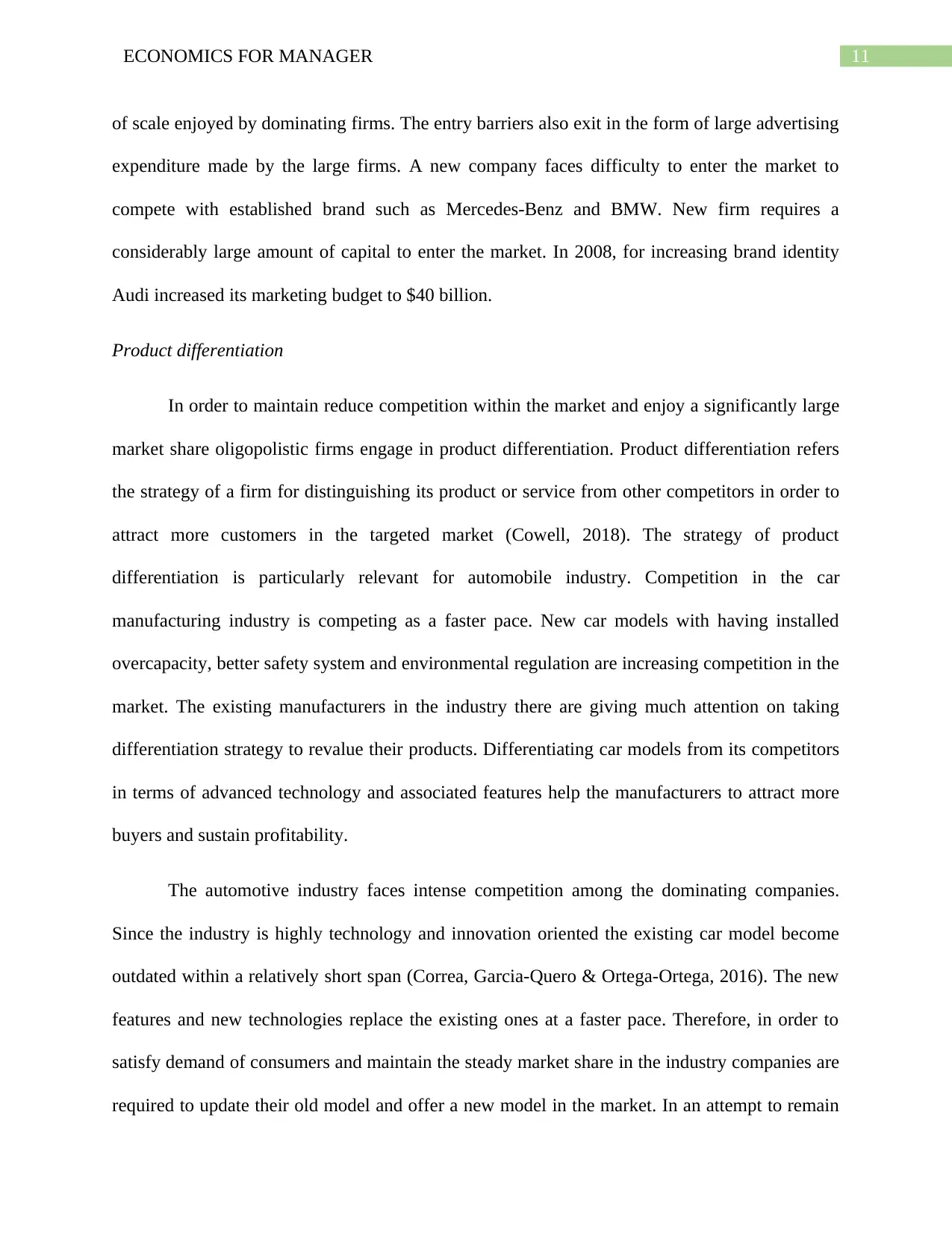
11ECONOMICS FOR MANAGER
of scale enjoyed by dominating firms. The entry barriers also exit in the form of large advertising
expenditure made by the large firms. A new company faces difficulty to enter the market to
compete with established brand such as Mercedes-Benz and BMW. New firm requires a
considerably large amount of capital to enter the market. In 2008, for increasing brand identity
Audi increased its marketing budget to $40 billion.
Product differentiation
In order to maintain reduce competition within the market and enjoy a significantly large
market share oligopolistic firms engage in product differentiation. Product differentiation refers
the strategy of a firm for distinguishing its product or service from other competitors in order to
attract more customers in the targeted market (Cowell, 2018). The strategy of product
differentiation is particularly relevant for automobile industry. Competition in the car
manufacturing industry is competing as a faster pace. New car models with having installed
overcapacity, better safety system and environmental regulation are increasing competition in the
market. The existing manufacturers in the industry there are giving much attention on taking
differentiation strategy to revalue their products. Differentiating car models from its competitors
in terms of advanced technology and associated features help the manufacturers to attract more
buyers and sustain profitability.
The automotive industry faces intense competition among the dominating companies.
Since the industry is highly technology and innovation oriented the existing car model become
outdated within a relatively short span (Correa, Garcia-Quero & Ortega-Ortega, 2016). The new
features and new technologies replace the existing ones at a faster pace. Therefore, in order to
satisfy demand of consumers and maintain the steady market share in the industry companies are
required to update their old model and offer a new model in the market. In an attempt to remain
of scale enjoyed by dominating firms. The entry barriers also exit in the form of large advertising
expenditure made by the large firms. A new company faces difficulty to enter the market to
compete with established brand such as Mercedes-Benz and BMW. New firm requires a
considerably large amount of capital to enter the market. In 2008, for increasing brand identity
Audi increased its marketing budget to $40 billion.
Product differentiation
In order to maintain reduce competition within the market and enjoy a significantly large
market share oligopolistic firms engage in product differentiation. Product differentiation refers
the strategy of a firm for distinguishing its product or service from other competitors in order to
attract more customers in the targeted market (Cowell, 2018). The strategy of product
differentiation is particularly relevant for automobile industry. Competition in the car
manufacturing industry is competing as a faster pace. New car models with having installed
overcapacity, better safety system and environmental regulation are increasing competition in the
market. The existing manufacturers in the industry there are giving much attention on taking
differentiation strategy to revalue their products. Differentiating car models from its competitors
in terms of advanced technology and associated features help the manufacturers to attract more
buyers and sustain profitability.
The automotive industry faces intense competition among the dominating companies.
Since the industry is highly technology and innovation oriented the existing car model become
outdated within a relatively short span (Correa, Garcia-Quero & Ortega-Ortega, 2016). The new
features and new technologies replace the existing ones at a faster pace. Therefore, in order to
satisfy demand of consumers and maintain the steady market share in the industry companies are
required to update their old model and offer a new model in the market. In an attempt to remain
⊘ This is a preview!⊘
Do you want full access?
Subscribe today to unlock all pages.

Trusted by 1+ million students worldwide
1 out of 23
Related Documents
Your All-in-One AI-Powered Toolkit for Academic Success.
+13062052269
info@desklib.com
Available 24*7 on WhatsApp / Email
![[object Object]](/_next/static/media/star-bottom.7253800d.svg)
Unlock your academic potential
Copyright © 2020–2025 A2Z Services. All Rights Reserved. Developed and managed by ZUCOL.





